
Wine Culture and Information since 2002 - Volume 22
 Wine Culture and Information since 2002 - Volume 22 |
|
Contrasts of Ansonica Costa dell'Argentario and Trebbiano d'AbruzzoTwo white wines produced in two different and distant territories, expression of equally different and distant grapes |
|
This month, in the glasses of our tasting by contrast, we are going to compare two wines produced in very different territories, both for their respective geographical positions and for the climatic conditions occurring in each of them. The two territories are also affected by the sea breezes, specifically, from the two Italian seas bordering the east and west coasts. The two wines we will examine this month are in fact Ansonica Costa dell'Argentario – therefore on the Tyrrhenian side – and Trebbiano d'Abruzzo, which is influenced by the Adriatic Sea. These are not – of course – meteorological conditions determined solely by the influence of the sea, as both territories are also affected from the conditions occurring in the internal parts of their respective production areas. In particular, the hinterland of Tuscany, near the Argentario, is characterized by flat and hilly territory, the one of Abruzzo – instead – is mainly characterized by hills and reaching the Apennine mountains. To this, of course, are added the differences introduced by the respective grapes used for the two wines – Ansonica for the wine of the Argentario area, Trebbiano d'Abruzzo for the Abruzzo wine – the result is therefore different in every regard. Two very different varieties producing equally different wines, however characterized by recognizable personalities. From a sensorial point of view, Ansonica Costa dell'Argentario and Trebbiano d'Abruzzo can be recognized for their rather different organoleptic qualities. If, in general terms, the Tuscan wine is capable of expressing finesse and elegance, with structures of good body, Trebbiano d'Abruzzo – which is certainly equally capable of finesse and elegance – gives the glass more robust and full wines. These characteristics also develop as a result of the climatic and meteorological conditions occurring in their respective territories, not least, the composition of the soil and the interpretation expressed by the producers. This last aspect, in fact, is certainly not negligible as the enological visions of Abruzzo and Tuscany differ substantially, also for historical and traditional reasons.
|
|
Ansonica is the name with which this white berried grape is found in the Italian national directory of vine varieties, therefore it is the official Italian name. This premise, which might seem superfluous, actually aims to introduce the identity of this variety and – above all – its origin. The Ansonica grape, in fact, is actually Inzolia, one of the most famous and widespread white grape varieties of Sicily. This grape is native to this island – where it is widely used for the production of both mono-varietal white wines and blended with other grapes – and from Sicily it reached Tuscany and other regions of Italy. Inzolia – Ansonica – is the oldest native white grape variety in Sicily and its origins, although today it is considered to be native to this island, are not entirely clear. The spreading in Tuscany, however, is limited to the territories near the Argentario mountain and in other Denominazione d'Origine Controllata areas in the province of Grosseto, to which is also added Elba island. Of all the Tuscan denominations providing for the use of Ansonica grape, the one of Costa dell'Argentario is the most famous and the only one exclusively reserved to this grape. The production area – recognized as a Denominazione d'Origine Controllata (Denomination of Controlled Origin, DOC) –covers the territories of Capalbio, Manciano, Orbetello, Mount Argentario and Giglio island, all in the province of Grosseto. The production disciplinary – according to what is generally provided for Italian wines with Denomination of Controlled Origin – provides for the minimum use of Ansonica for 85%, while the remaining part can be made from white grape varieties permitted to cultivation in Tuscany. The Ansonica Costa dell'Argentario is a wine having a remarkable finesse and elegance, and is characterized by the pleasing crispness given by acidity, as well as the olfactory profile of flowers and fruits. For this reason, almost all the wines belonging to the appellation are vinified and aged in inert containers, with the aim of preserving the quality of the typical organoleptic characteristics of this wine.
|
||||
|
Undisputed glory of Abruzzo, the local Trebbiano shares the wine scene of this region with another great grape – Montepulciano – from which are produced the homonymous red and Cerasuolo wines. The famous white of Abruzzo, although the situation has today become more clear, has been for decades the subject of confusion regarding the grape with which it is produced. This was also because of the not so clear situation concerning, for many reasons, the Italian grapes that are characterized by the name “Trebbiano”. As is widely known, the term “Trebbiano” comes from Trebula, the name with which many towns in central Italy were called in ancient times, therefore from trebulanum, a term used to refer to an “estate” near Trebula. The term trebulanum could therefore be translated as “farm” or “agricultural estate”. From this originates the word Trebbiano, a term used by Pliny the Elder for the definition of vinum trebulanum and which today we could translate as “country wine” or “farm wine”. In other words, the grape – and therefore the wine – of the place. Nowadays, every Trebbiano grape is generally considered as a member of the same family, although – in many cases – there are no common analogies. As for Trebbiano d'Abruzzo, probably also because of the confusion existing in the large family of these grapes, for a long time it was confused with Bombino Bianco, a grape widely spread in the areas of central-southern Italy. Today, thanks to scientific research, we know that, in reality, Trebbiano d'Abruzzo – also known as Trebbiano Abruzzese – has no connection or analogy with Bombino Bianco, it indeed turns out to have several similarities with Biancame, a biotype of Trebbiano Toscano. This confusion, which lasted for decades, has however produced quite a big confusion in the enological definition of Trebbiano d'Abruzzo. Its production disciplinary, in fact, still provides for the possibility of using Trebbiano Abruzzese, Bombino Bianco and Trebbiano Toscano, alone or together, for a minimum of 85%. Trebbiano d'Abruzzo, when produced with viticultural and enological quality criteria, is a white capable of remarkable organoleptic expression. This characteristic allows producers to interpret this grape – and therefore the wine – with countless enological practices, from vinification in inert containers to the use of casks and barriques, giving, in all cases, wines of good sensorial interest.
|
Before starting this month's tasting by contrast, let's search for the bottles of the two wines. It should be noted, these wines are pretty easy to find on the market, and are certainly available in any well-stocked wine shop. This is particularly true for Trebbiano d'Abruzzo, as the total volume of production is much greater than for Ansonica Costa dell'Argentario. The wines we will consider are both produced by fermentation and aging in inert containers, preferably in steel tanks. In this regard, it should be noted this is the method generally used for the production of these two wines, this further simplifying the search. As for the composition – although the respective production disciplinary provide for a minimum 85% of the primary variety – we will make sure they actually are wines produced with the respective identifying grapes only. The two wines belong to the last available vintage and are served in tasting glasses at a temperature of 10 °C. (50 °F) Let's start our tasting by contrast and proceed with the analysis of the first sensorial quality of the wines, represented by their appearance, that is how they appear to our eyes in terms of color and transparency. The first wine we will examine is Ansonica Costa dell'Argentario. Let's tilt the glass over a white surface – a sheet of paper is enough – and observe the base, where the thickness of the liquid mass is greater. The color of the Tuscan wine reveals a brilliant and intense straw yellow, while the nuance – observed at the upper edge of the glass, towards the opening, at the point where the thickness of the wine is thinnest – is characterized by a greenish yellow color. The transparency of Ansonica Costa dell'Argentario, evaluated by placing an object between the glass and the white surface, is very high. Let's now pass to the evaluation of the aspect of Trebbiano d'Abruzzo and, just like for the previous wine, let's tilt the glass over the white surface. The color of the Abruzzo wine, observed at the base of the glass, reveals an intense straw yellow, generally darker than Ansonica Costa dell'Argentario. The nuance, observed towards the opening of the glass, confirms the straw yellow color. The transparency of Trebbiano d'Abruzzo is also very high. The olfactory profiles of Ansonica and Trebbiano Abruzzese are characterized by substantial differences, although it is possible to perceive common aromas. In both cases, the olfactory profiles are expressed with aromas that directly recall the world of yellow and white fruits, as well as flowers. The Ansonica – in the Maremma area – mainly expresses aromas reminiscent of apple, pear, plum and citrus fruits, while, as for the olfactory qualities attributable to the world of flowers, this variety is characterized by hawthorn, broom and chamomile. In some cases, in the Ansonica Costa dell'Argentario can be perceived aromas reminiscent of aromatic herbs, especially lesser calamint. The aromas characterizing Trebbiano d'Abruzzo, although they have common qualities with Ansonica, are more intense and, so to speak, more robust, in which can be perceived, also in this case, aromas of apple, pear and plum. To these fruity sensations are often added lemon, peach, medlar and hints of tropical fruit, in particular pineapple. Furthermore, in Trebbiano d'Abruzzo, can often be perceived the scent of almond. As for the aromas belonging to the world of flowers, in Trebbiano d'Abruzzo can be mainly perceived hawthorn and broom. Let's resume the tasting by contrast of this month and proceed with the olfactory examination of Ansonica Costa dell'Argentario and Trebbiano d'Abruzzo. As for the previous examination, the first wine of which we analyze the aromas is the Tuscan one. Let's hold the glass in vertical position and let's do the first smell in order to appreciate the opening, that is the identifying aromas. In the Ansonica Costa dell'Argentario can be perceived aromas of apple, pear and plum, followed by the floral scent of hawthorn. Let's proceed with the swirling of the glass – operation that will favor the development of the remaining aromas – then let's do the second smell. The olfactory profile of the Tuscan wine is completed with broom, chamomile, citrus fruit, peach, hazelnut and, often, the elegant hint of aromatic herbs in which we recognize lesser calamint. Let's move on to the evaluation of the olfactory profile of Trebbiano d'Abruzzo and – by holding the glass in vertical position, without swirling it – let's do the first smell in order to appreciate its opening. From the glass we perceive aromas of apple, plum and hawthorn. After having swirled the glass, the olfactory profile of Trebbiano d'Abruzzo is completed with aromas of pear, broom, pineapple, lemon and almond. Let's now move on to the analysis of the gustatory profiles of Ansonica Costa dell'Argentario and Trebbiano d'Abruzzo, first examining – as in the previous phases – the Tuscan wine. Let's therefore take a sip of this wine and evaluate its attack, that is, the initial sensations perceived in the mouth. The wine expresses a marked crispness given by the acidity that finds balance in the effect of alcohol, the latter of moderate intensity but enough to contrast acidity. Ansonica Costa dell'Argentario has a medium structure, definitely suited to the personality of the wine, and in the mouth we perceive the flavors of apple, pear and plum, confirming the good correspondence to the nose. Let's now proceed with the evaluation of the attack of Trebbiano d'Abruzzo and take a sip of this wine. In the Abruzzo white can be immediately appreciated crispness – given by the acidity – and, also in this case, promptly balanced by the effect of alcohol, generally more intense than Ansonica Costa dell'Argentario. The structure of the wine – compared with that of the Tuscan white – is more robust as well as the sensation of roundness. In the mouth are perceived flavors of apple, plum and almond, confirming the good correspondence to the nose. After having swallowed the wines, let's terminate this month's tasting by contrast by evaluating the final sensations, in particular the taste-olfactory persistence. The finish of Ansonica Costa dell'Argentario is of good persistence, in the mouth we continue to perceive the pleasing crispness given by the acidity and the sensation of moderate structure. In the mouth we can also perceive the flavors of apple, pear and plum. The finish of Trebbiano d'Abruzzo is equally persistent – in both wines, persistence can be measured in about ten seconds – and the pleasing crispness of acidity continues to be perceived in the mouth as well as the warm effect of the alcohol. The sensation of structure is – even in the finish – fuller than in Tuscan wine, continuing to be perceived the flavors of apple, plum, pineapple and the slightly bitter sensation in which we recognize almond. Before concluding the tasting by contrast, place the two glasses next to each other and do a further smell. The olfactory profiles of the two wines are very different, although they have common characteristics however expressed with different intensities.
|
||||||||
Wines of the Month |
|
|
|
Score legend Prices are to be considered as indicative. Prices may vary according to the country or the shop where wines are bought |
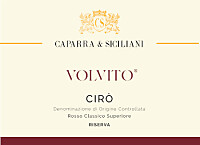
|
|
Cirò Rosso Classico Superiore Riserva Volvito 2018 |
|
| Caparra & Siciliani (Calabria, Italy) | |
 Gaglioppo Gaglioppo | |
| Price: € 15.00 | Score: |
 Intense ruby red and nuances of garnet red, little transparency. Intense ruby red and nuances of garnet red, little transparency. Intense, clean, pleasing, refined and elegant, starts with hints of
plum, black cherry and dried violet followed by aromas of blueberry,
tobacco, cocoa, leather, mace, licorice, black pepper, vanilla and menthol. Intense, clean, pleasing, refined and elegant, starts with hints of
plum, black cherry and dried violet followed by aromas of blueberry,
tobacco, cocoa, leather, mace, licorice, black pepper, vanilla and menthol.
 Properly tannic attack and however balanced by alcohol, good body,
intense flavors, agreeable. Properly tannic attack and however balanced by alcohol, good body,
intense flavors, agreeable.
 Persistent finish with flavors of plum, black cherry and blueberry. Persistent finish with flavors of plum, black cherry and blueberry. 24 months in barrique, 6 months in bottle. 24 months in barrique, 6 months in bottle. |
|
 Roasted meat, Stewed meat with mushrooms, Broiled meat and barbecue Roasted meat, Stewed meat with mushrooms, Broiled meat and barbecue |
|
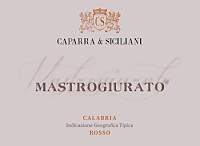
|
|
Mastrogiurato 2019 |
|
| Caparra & Siciliani (Calabria, Italy) | |
 Gaglioppo (70%), Greco Nero (30%) Gaglioppo (70%), Greco Nero (30%) | |
| Price: € 18.00 | Score: |
 Deep ruby red and nuances of ruby red, little transparency. Deep ruby red and nuances of ruby red, little transparency. Intense, clean, pleasing, refined and elegant, starts with hints of
plum, blackberry and black cherry followed by aromas of violet, carnation,
raspberry, blueberry, cocoa, tobacco, mace, vanilla and menthol. Intense, clean, pleasing, refined and elegant, starts with hints of
plum, blackberry and black cherry followed by aromas of violet, carnation,
raspberry, blueberry, cocoa, tobacco, mace, vanilla and menthol.
 Properly tannic attack and however balanced by alcohol, good body,
intense flavors, agreeable. Properly tannic attack and however balanced by alcohol, good body,
intense flavors, agreeable.
 Persistent finish with flavors of plum, black cherry and raspberry. Persistent finish with flavors of plum, black cherry and raspberry. Aged in barrique. Aged in barrique. |
|
 Roasted meat, Stewed meat with mushrooms, Broiled meat and barbecue, Cheese Roasted meat, Stewed meat with mushrooms, Broiled meat and barbecue, Cheese |
|
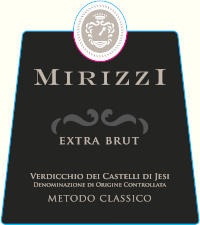
|
|
Verdicchio dei Castelli di Jesi Spumante Metodo Classico Extra Brut Mirizzi 2017 |
|
| Montecappone (Marches, Italy) | |
 Verdicchio Verdicchio | |
| Price: € 26.50 | Score: |
 Brilliant straw yellow and nuances of straw yellow, very transparent,
fine and persistent perlage. Brilliant straw yellow and nuances of straw yellow, very transparent,
fine and persistent perlage.
 Intense, clean, pleasing, refined and elegant, starts with hints of
apple, plum and bread crust followed by aromas of hawthorn, broom,
grapefruit, pineapple, pear, peach, walnut husk, linden, honey and almond. Intense, clean, pleasing, refined and elegant, starts with hints of
apple, plum and bread crust followed by aromas of hawthorn, broom,
grapefruit, pineapple, pear, peach, walnut husk, linden, honey and almond.
 Effervescent and crisp attack, however balanced by alcohol, good body,
intense flavors, agreeable. Effervescent and crisp attack, however balanced by alcohol, good body,
intense flavors, agreeable.
 Persistent finish with flavors of apple, plum and grapefruit. Persistent finish with flavors of apple, plum and grapefruit. Refermented in bottle and aged on its lees for 24 months. Refermented in bottle and aged on its lees for 24 months. |
|
 Pasta and risotto with crustaceans and fish, Roasted white meat, Roasted fish, Mushroom soups Pasta and risotto with crustaceans and fish, Roasted white meat, Roasted fish, Mushroom soups |
|
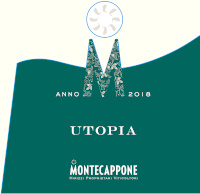
|
|
Castelli di Jesi Verdicchio Riserva Classico Utopia 2018 |
|
| Montecappone (Marches, Italy) | |
 Verdicchio Verdicchio | |
| Price: € 26.50 | Score: |
 Intense straw yellow and nuances of straw yellow, very transparent. Intense straw yellow and nuances of straw yellow, very transparent. Intense, clean, pleasing, refined and elegant, starts with hints of
apple, plum and citron followed by aromas of hawthorn, broom, chamomile,
pear, pineapple, medlar, peach, anise, thyme and almond. Intense, clean, pleasing, refined and elegant, starts with hints of
apple, plum and citron followed by aromas of hawthorn, broom, chamomile,
pear, pineapple, medlar, peach, anise, thyme and almond.
 Crisp attack and however balanced by alcohol, good body, intense
flavors, agreeable. Crisp attack and however balanced by alcohol, good body, intense
flavors, agreeable.
 Persistent finish with flavors of apple, plum and citron. Persistent finish with flavors of apple, plum and citron. 9 months in steel tanks. 9 months in steel tanks. |
|
 Pasta with fish, Sauteed white meat, Stewed fish, Fried fish, Cheese Pasta with fish, Sauteed white meat, Stewed fish, Fried fish, Cheese |
|
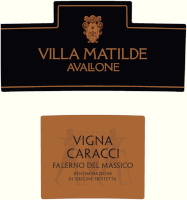
|
|
Falerno del Massico Bianco Vigna Caracci 2017 |
|
| Villa Matilde (Campania, Italy) | |
 Falanghina Falanghina | |
| Price: € 27.00 | Score: |
 Brilliant golden yellow and nuances of golden yellow, very transparent. Brilliant golden yellow and nuances of golden yellow, very transparent. Intense, clean, pleasing, refined and elegant, starts with hints of
apple, plum and hawthorn followed by aromas of broom, pear, citrus fruits,
pineapple, medlar, honey, hazelnut and hints of vanilla. Intense, clean, pleasing, refined and elegant, starts with hints of
apple, plum and hawthorn followed by aromas of broom, pear, citrus fruits,
pineapple, medlar, honey, hazelnut and hints of vanilla.
 Crisp attack and however balanced by alcohol, good body, intense
flavors, pleasing roundness. Crisp attack and however balanced by alcohol, good body, intense
flavors, pleasing roundness.
 Persistent finish with flavors of apple, plum and hazelnut. Persistent finish with flavors of apple, plum and hazelnut. 3 months in amphora. A small part ferments in barrique. 3 months in amphora. A small part ferments in barrique. |
|
 Stuffed pasta with fish, Roasted fish, Broiled fish, Roasted white meat, Mushroom soups Stuffed pasta with fish, Roasted fish, Broiled fish, Roasted white meat, Mushroom soups |
|
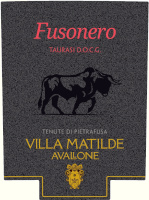
|
|
Taurasi Fusonero 2015 |
|
| Villa Matilde (Campania, Italy) | |
 Aglianico Aglianico | |
| Price: € 25.00 | Score: |
 Deep ruby red and nuances of ruby red, little transparency. Deep ruby red and nuances of ruby red, little transparency. Intense, clean, pleasing, refined and elegant, starts with hints of
plum, black cherry and blackberry followed by aromas of dried violet,
blueberry, chocolate, tobacco, leather, licorice, mace, vanilla and
menthol. Intense, clean, pleasing, refined and elegant, starts with hints of
plum, black cherry and blackberry followed by aromas of dried violet,
blueberry, chocolate, tobacco, leather, licorice, mace, vanilla and
menthol.
 Properly tannic attack and however balanced by alcohol, full body,
intense flavors, agreeable. Properly tannic attack and however balanced by alcohol, full body,
intense flavors, agreeable.
 Persistent finish with flavors of plum, black cherry and blackberry. Persistent finish with flavors of plum, black cherry and blackberry. 18 months in cask and barrique, 12 months in bottle. 18 months in cask and barrique, 12 months in bottle. |
|
 Game, Roasted meat, Stewed and braised meat with mushrooms, Hard cheese Game, Roasted meat, Stewed and braised meat with mushrooms, Hard cheese |
|
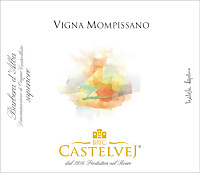
|
|
Barbera d'Alba Superiore Vigna Monpissano 2018 |
|
| Bric Castelvej (Piedmont, Italy) | |
 Barbera Barbera | |
| Price: € 15.00 | Score: |
 Intense ruby red and nuances of ruby red, little transparency. Intense ruby red and nuances of ruby red, little transparency. Intense, clean, pleasing and refined, starts with hints of cherry, plum
and violet followed by aromas of blueberry, blackberry, raspberry, tobacco,
chocolate, mace, cardamom and vanilla. Intense, clean, pleasing and refined, starts with hints of cherry, plum
and violet followed by aromas of blueberry, blackberry, raspberry, tobacco,
chocolate, mace, cardamom and vanilla.
 Properly tannic attack and however balanced by alcohol, good body,
intense flavors, pleasing crispness. Properly tannic attack and however balanced by alcohol, good body,
intense flavors, pleasing crispness.
 Persistent finish with flavors of cherry, plum and blueberry. Persistent finish with flavors of cherry, plum and blueberry. Aged in cask. Aged in cask. |
|
 Stuffed pasta with meat and mushrooms, Broiled meat and barbecue, Roasted meat, Stewed meat with mushrooms, Cheese Stuffed pasta with meat and mushrooms, Broiled meat and barbecue, Roasted meat, Stewed meat with mushrooms, Cheese |
|
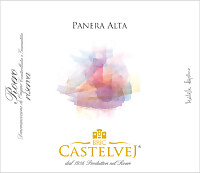
|
|
Roero Riserva Panera Alta 2016 |
|
| Bric Castelvej (Piedmont, Italy) | |
 Nebbiolo Nebbiolo | |
| Price: € 24.50 | Score: |
 Intense ruby red and nuances of garnet red, little transparency. Intense ruby red and nuances of garnet red, little transparency. Intense, clean, pleasing, refined and elegant, starts with hints of
cherry, plum and dried violet followed by aromas of rose, raspberry, cocoa,
cinnamon, tobacco, mace, licorice, leather, vanilla and menthol. Intense, clean, pleasing, refined and elegant, starts with hints of
cherry, plum and dried violet followed by aromas of rose, raspberry, cocoa,
cinnamon, tobacco, mace, licorice, leather, vanilla and menthol.
 Tannic attack and however balanced by alcohol, full body, intense
flavors, pleasing crispness. Tannic attack and however balanced by alcohol, full body, intense
flavors, pleasing crispness.
 Persistent finish with flavors of cherry, plum and raspberry. Persistent finish with flavors of cherry, plum and raspberry. 30 months in cask, 6 months in bottle. 30 months in cask, 6 months in bottle. |
|
 Game, Roasted meat, Stewed and braised meat, Cheese Game, Roasted meat, Stewed and braised meat, Cheese |
|
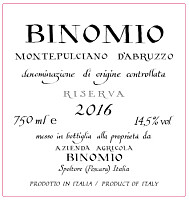
|
|
Montepulciano d'Abruzzo Riserva Binomio 2016 |
|
| La Valentina (Abruzzo, Italy) | |
 Montepulciano Montepulciano | |
| Price: € 42.00 | Score: |
 Deep ruby red and nuances of garnet red, little transparency. Deep ruby red and nuances of garnet red, little transparency. Intense, clean, pleasing, refined and elegant, starts with hints of
plum, black cherry and blueberry followed by aromas of dried violet, peony,
blackberry, cocoa, tobacco, mace, licorice, pink pepper, leather, graphite,
vanilla and menthol. Intense, clean, pleasing, refined and elegant, starts with hints of
plum, black cherry and blueberry followed by aromas of dried violet, peony,
blackberry, cocoa, tobacco, mace, licorice, pink pepper, leather, graphite,
vanilla and menthol.
 Properly tannic attack and however balanced by alcohol, full body,
intense flavors, pleasing roundness. Properly tannic attack and however balanced by alcohol, full body,
intense flavors, pleasing roundness.
 Very persistent finish with long flavors of plum, black cherry and
blueberry. Very persistent finish with long flavors of plum, black cherry and
blueberry.
 15 months in barrique. 15 months in barrique. |
|
 Game, Roasted meat, Stewed and braised meat, Hard cheese Game, Roasted meat, Stewed and braised meat, Hard cheese |
|
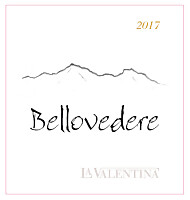
|
|
Montepulciano d'Abruzzo Riserva Terre dei Vestini Bellovedere 2017 |
|
| La Valentina (Abruzzo, Italy) | |
 Montepulciano Montepulciano | |
| Price: € 50.00 | Score: |
 Deep ruby red and nuances of ruby red, little transparency. Deep ruby red and nuances of ruby red, little transparency. Intense, clean, pleasing, refined and elegant, starts with hints of
black cherry, plum and blackberry followed by aromas of violet, blueberry,
cocoa, tobacco, cinnamon, leather, licorice, rosemary, juniper, pink
pepper, vanilla and menthol. Intense, clean, pleasing, refined and elegant, starts with hints of
black cherry, plum and blackberry followed by aromas of violet, blueberry,
cocoa, tobacco, cinnamon, leather, licorice, rosemary, juniper, pink
pepper, vanilla and menthol.
 Properly tannic attack and however balanced by alcohol, full body,
intense flavors, agreeable. Properly tannic attack and however balanced by alcohol, full body,
intense flavors, agreeable.
 Very persistent finish with long flavors of plum, black cherry and
blackberry. Very persistent finish with long flavors of plum, black cherry and
blackberry.
 18 months in cask and barrique, 12 months in bottle. 18 months in cask and barrique, 12 months in bottle. |
|
 Game, Roasted meat, Stewed and braised meat, Hard cheese Game, Roasted meat, Stewed and braised meat, Hard cheese |
|
|
||||||||
|
DiWineTaste Polls
|
| |||||||
Privacy Policy | |||||||


| Copyright © 2002-2024 Antonello Biancalana, DiWineTaste - All rights reserved |
| All rights reserved under international copyright conventions. No part of this publication and of this WEB site may be
reproduced or utilized in any form or by any means, electronic or mechanical, without permission in writing from DiWineTaste. |